List of World Heritage Sites in Tunisia
The United Nations Educational, Scientific and Cultural Organization (UNESCO) World Heritage Sites are places of importance to cultural or natural heritage as described in the UNESCO World Heritage Convention, established in 1972.[1] Cultural heritage consists of monuments (such as architectural works, monumental sculptures, or inscriptions), groups of buildings, and sites (including archaeological sites). Natural features (consisting of physical and biological formations), geological and physiographical formations (including habitats of threatened species of animals and plants), and natural sites which are important from the point of view of science, conservation or natural beauty, are defined as natural heritage.[2] Tunisia accepted the convention on 10 March 1975, making its historical sites eligible for inclusion on the list.[3]
Tunisia has nine sites on the list, eight of which are listed for their cultural significance and one, the Ichkeul National Park, for natural significance. This site was listed endangered between 1996 and 2006 because of construction of dams that threatened the hydrological regime of the lake and resulted in reduction of vegetation and drop in bird numbers. By 2006 the situation has improved so the site was removed from the endangered list.[4] The first three sites were listed in 1979 and the most recent, Djerba, in 2023.[3] In addition, Tunisia has 15 sites on the tentative list.[3] The country has served on the World Heritage Committee four times.[3]
World Heritage Sites[edit]
UNESCO lists sites under ten criteria; each entry must meet at least one of the criteria. Criteria i through vi are cultural, and vii through x are natural.[5]
| Site | Image | Location (governorate) | Year listed | UNESCO data | Description |
|---|---|---|---|---|---|
| Medina of Tunis | 
|
Tunis | 1979 | 36bis; ii, iii, v (cultural) | Tunis was founded in 698 as one of the first Arab cities in the Maghreb. It reached its peak between the 12th to the 16th centuries, under the Almohads and Hafsids, when it was one of the wealthiest cities of the Islamic world. Due to its location, it was a linking point between the Maghreb, Europe and the East. Numerous monuments in the medina have been preserved, including several city gates, the Kasbah Mosque (pictured), noble houses, souks, and a cemetery. A minor boundary modification of the site took place in 2010.[6] |
| Archaeological Site of Carthage | 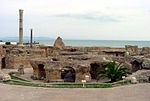
|
Tunis | 1979 | 37; ii, iii, vi (cultural) | Founded in the 9th century BCE by the Phoenicians, Carthage developed into a trading empire spanning the Mediterranean. It was a major rival to the Roman Republic which resulted in a series of wars until the city was ultimately destroyed in 146 BCE. It was later reestablished as Roman Carthage. Remains of buildings from different periods have been preserved, including temples, a theater, public baths, necropolises, cisterns, and residential buildings.[7] |
| Amphitheatre of El Jem | 
|
Mahdia | 1979 | 38bis; iv, vi (cultural) | The 3rd century amphitheatre of Thysdrus, today known as El Jem, is North Africa's largest amphitheatre. It was modeled after the Colosseum in Rome. It is estimated it had a capacity of 35,000 spectators. The fact that such an imposing building was constructed in a rather remote province is a sign of Roman imperial propaganda. A minor boundary modification of the site took place in 2010.[8] |
| Ichkeul National Park | 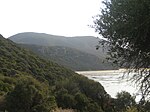
|
Bizerte | 1980 | 8; x (natural) | The freshwater lake and the surrounding wetlands are the remains of a much larger chain of lakes. It is an important wintering habitat for hundreds of thousands of migratory birds, especially geese, coots, and ducks, such as the white-headed duck, ferruginous duck, and the marbled duck. Other birds include storks and flamingos. The site was listed endangered between 1996 and 2006 because of construction of dams that threatened the hydrological regime of the lake and resulted in reduction of vegetation and drop in bird numbers. By 2006, the situation has improved so the site was removed from the endangered list.[9][4] |
| Punic Town of Kerkuane and its Necropolis | 
|
Nabeul | 1985 | 332bis; iii (cultural) | The Phoenicio–Punic town of Kerkouane was abandoned around 250 BCE during the First Punic War. As opposed to several Phoenician cities, such as Carthage, Byblos, or Tyre, it was not rebuilt under the Romans. The ruins, which date to the 4th and 3th centuries BCE and were discovered in 1952, provide an important insight in the Punic urban planning. The nearby necropolis that provides insight into the Punic funerary practices was added to the site in 1986.[10] |
| Medina of Sousse | 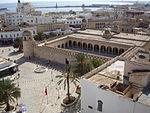
|
Sousse | 1988 | 498bis; iii, iv, v (cultural) | The coastal town of Sousse became important in the 9th century under the Aghlabids as a part of the defense system to protect against piracy and other attacks from the sea. The medina has been well preserved, with several monuments, including the Ribat, which is both a fortification and a religious building, the Great Mosque (pictured), the kasbah, the Bou Ftata Mosque, and fortifications. A minor boundary modification of the site took place in 2010.[11] |
| Kairouan | 
|
Kairouan | 1988 | 499bis; i, ii, iii, v, vi (cultural) | Kairouan was founded in 670 as one of the first Arabo-Muslim cities in the Maghreb. It served as the capital of Ifriqiya for five centuries and flourished under the Aghlabids in the 9th century. There are numerous monuments in the city, including the Great Mosque (pictured) the Mosque of the Three Doors, the medina, walls, and gates. Kairouan is one of the holiest cities of Islam. A minor boundary modification of the site took place in 2010.[12] |
| Dougga / Thugga | 
|
Béja | 1997 | 794; ii, iii (cultural) | Dougga encompasses the ruins of a small Roman town, with most buildings dating to the 2nd and 3rd centuries CE. The Roman town was founded on a site of an important Libyan–Punic settlement which was probably the first capital of the Numidian Kingdom. The town declined in the Byzantine and Islamic periods. Monuments include the Roman theatre (pictured) and the Libyco-Punic Mausoleum. Numerous inscriptions in several regional languages were found on site and provide an insight into the daily life on the fringes of the Roman Empire.[13] |
| Djerba: Testimony to a settlement pattern in an island territory | 
|
Medenine | 2023 | 1640; v (cultural) | The island of Djerba has a semi dry climate and water is scarce. This resulted in a specific settlement pattern that developed around the 9th century, with a series of low-density neighborhoods connected with roads. An old well is pictured.[14] |
Tentative list[edit]
In addition to sites inscribed on the World Heritage List, member states can maintain a list of tentative sites that they may consider for nomination. Nominations for the World Heritage List are only accepted if the site was previously listed on the tentative list.[15] Tunisia maintains 15 properties on its tentative list.[3]
| Site | Image | Location (governorate) | Year listed | UNESCO criteria | Description |
|---|---|---|---|---|---|
| El Feidja National Park | 
|
Jendouba | 2008 | vii, viii, x (natural) | The park is home to oak forests, with species Quercus faginea and Quercus suber. The forests have rich undergrowth with several medicinal and aromatic plants, the knowledge of which has been passed down through generations. The Barbary stag lives here while the Barbary lion has been extinct since the 20th century.[16] |
| Bou-Hedma National Park | 
|
Sidi Bouzid | 2008 | vii, viii, x (natural) | The park covers remnants of an ancient pre-Saharan savanna, similar to the one of the Sahel. It used to be inhabited by several large mammals such as elephants and antelopes, but they have gradually disappeared. In the 1980s, the scimitar oryx, addax, and ostrich have been reintroduced to the area. There are also Roman archaeological remains in the park.[17] |
| Chott el Djerid | 
|
Kebili | 2008 | vii, viii, ix, x (natural) | Chott el Djerid is a chott, a salt lake that stays dry most of the year but occasionally fills with water. During humid periods, it was a permanent lake up to 25 m (82 ft) deep. Traces of aquatic life have been preserved. Several species of waterbirds visit the lake, including large flocks of flamingos.[18] |
| Gabès Oasis | 
|
Gabès | 2008 | iv, vii, x (mixed) | The Gabès Oasis, located at the Mediterranean coast, is a rare type of a coastal oasis. It is a refuge for several species of small mammals and reptiles and it serves as a stopover for migratory birds. Date palms, fruit trees, and garden vegetables are grown here. Agriculture is assisted by a network of irrigation channels that have been used for millennia.[19] |
| Royal Mausolea of Numidia, Mauretania, and Pre-Islamic Funerary Monuments | 
|
several sites | 2012 | ii, iii, iv (cultural) | This nomination comprises a series of mausolea and funerary monuments across Tunisia. They vary in architectural styles and reflect the interactions between the cultures of the Maghreb. The monuments include the Libyco-Punic Mausoleum of Dougga (pictured, already listed a part of the World Heritage Site of Dougga), the necropolis of Chemtou, the megalithic dolmens of Eles, the monuments at Maktar, and the mausoleum of Henchir Bourgou in Djerba.[20] |
| Roman Hydraulic Complex of Zaghouan-Carthage | 
|
several sites | 2012 | i, iv (cultural) | The Roman hydraulic complex, built in the early 2nd century, comprises the catchment area with four main springs at Zaghouan, the aqueduct (section pictured) that carries water for 132 km (82 mi) to Carthage and has sections with arches up to 20 m (66 ft) tall, and the infrastructure at the end stage, including the Cisterns of La Malga and the Baths of Antoninus.[21] |
| Ancient Quarries of Numidian Marbles in Chemtou | 
|
Jendouba | 2012 | ii, iv (cultural) | The quarries of Chemtou produced marble for over six centuries, first in the 2nd century BCE and later under Rome, when the so-called Numidian marble became a prized commodity for decoration of patrician residences and public monuments across the Empire. Marble was quarried by slaves and convicts under the supervision of the army. The remains of a military camp have been preserved.[22] |
| Frontier of the Roman Empire: South Tunisian Limes | 
|
several sites | 2012 | ii, iii, iv (cultural) | This nomination comprises a series of fortifications, walls, camps, and other support structures that formed the southern Borders of the Roman Empire. Construction started under Emperor Augustus in the early 1st century. As opposed to several sections of Roman Limes in Europe, that are already listed as World Heritage Sites, this section was constructed in a desert setting, which called for different engineering solutions. Ksar Ghilane is pictured.[23] |
| Medina of Sfax | 
|
Sfax | 2012 | ii, iv, v (cultural) | Founded in the mid-9th century, Sfax was the gateway and the port of Ifriqiya to the Levant. The medina quarter is laid on a rectangular plan and is one of the best examples of Arabo-Muslim urbanism in the Mediterranean basin. The city plan is similar to the one of Kufa, the first Arabo-Muslim city. The medina is dominated by the Great Mosque.[24] |
| Permian Marine of Jebel Tebaga | 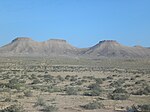
|
Médenine | 2016 | vii, viii (natural) | Geological formation of Jebel Tebaga dates to the late Permian period, before the Permian–Triassic extinction event. Fossils found in the formation illustrate the marine life of the period, including trilobites from the genus Pseudophillipsia.[25] |
| Stratotype of the Cretaceous–Tertiary (K-T) Boundary | Kef | 2016 | vii, viii (natural) | Geological formation along the Oued Mallègue river exhibits a clear sequence of sediments spanning across the Cretaceous–Paleogene boundary, with a thin iridium-rich layer of clay marking the Cretaceous–Paleogene extinction event supporting the theory that the extinction was caused by the asteroid impact.[26] | |
| Jugurtha Tableland near Kalaat es Senam | 
|
Kef | 2017 | ii, iii, v, vi, vii, viii (mixed) | Jugurtha Tableland is a large mesa near the town of Kalaat es Senam. It is named after Numidian king Jugurtha who took shelter here during a battle with the Rome between 107 and 105 BCE, before he was ultimately defeated. There is a fort (qalat) on the top that was used in different historical periods, as well as prehistoric remains such as dolmens. Geologically, the formation is an example of an inverted relief and shows typical processes of erosion.[27] |
| Troglodyte Habitat and the World of the Ksour of Southern Tunisia | 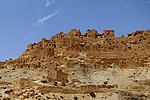
|
several sites | 2020 | iv, v (cultural) | This nomination illustrates traditional forms of human settlement and land use that are representative of the ways of life of indigenous communities in southern Tunisia and their interaction with an unfavourable, even hostile natural environment. It comprises two large troglodyte complexes and a series of ksour, traditional fortified villages in the region. Ksar Chenini is pictured.[28] |
| Rammadiya d'El Magtaa (El Mekta), the reference site of the Capsian culture | 
|
Gafsa | 2021 | iii (cultural) | Rammadiya d'El Magtaa near Gafsa is an archaeological site of the Capsian culture, dating to 10,000 to 7,000 years before present, when the area was an open savanna. People of the Capsian culture were hunter-gatherers that left stone figures, petroglyphs, and carved ostrich eggs (drawing of an example pictured).[29] |
| Archaeological site of Sbeitla | 
|
Kasserine | 2021 | ii (cultural) | The Roman town of Sufetula Musuniorum was founded in the 1st century CE as an administrative centre of a region inhabited by nomadic tribes. It was a typical colonial Roman settlement with temples, Roman baths, and an triumphant arch (pictured). It was later used by the Byzantines and Gregory the Patrician, who in 647 declared independence before being defeated in the same year by the Arabs. This marked the end of the Byzantine domination in North Africa.[30] |
See also[edit]
References[edit]
- ^ "The World Heritage Convention". UNESCO World Heritage Centre. Archived from the original on 27 August 2016. Retrieved 21 September 2010.
- ^ "Convention Concerning the Protection of the World Cultural and Natural Heritage". UNESCO World Heritage Centre. Archived from the original on 1 February 2021. Retrieved 3 February 2021.
- ^ a b c d e "Tunisia". UNESCO World Heritage Centre. Archived from the original on 13 June 2023. Retrieved 24 November 2019.
- ^ a b "Thirtieth Session: State of conservation reports of the properties inscribed on the List of World Heritage in Danger" (PDF). UNESCO World Heritage Centre. Retrieved 24 November 2019.
- ^ "The Criteria for Selection". UNESCO World Heritage Centre. Archived from the original on 12 June 2016. Retrieved 17 August 2018.
- ^ "Medina of Tunis". UNESCO World Heritage Centre. Archived from the original on 19 November 2005. Retrieved 17 August 2011.
- ^ "Archaeological Site of Carthage". UNESCO World Heritage Centre. Archived from the original on 4 September 2022. Retrieved 17 August 2011.
- ^ "Amphitheatre of El Jem". UNESCO World Heritage Centre. Archived from the original on 22 June 2020. Retrieved 17 August 2011.
- ^ "Ichkeul National Park". UNESCO World Heritage Centre. Archived from the original on 19 November 2005. Retrieved 17 August 2011.
- ^ "Punic Town of Kerkuane and its Necropolis". UNESCO World Heritage Centre. Archived from the original on 2 August 2022. Retrieved 17 August 2011.
- ^ "Medina of Sousse". UNESCO World Heritage Centre. Archived from the original on 20 December 2005. Retrieved 17 August 2011.
- ^ "Kairouan". UNESCO World Heritage Centre. Archived from the original on 23 August 2022. Retrieved 17 August 2011.
- ^ "Dougga / Thugga". UNESCO World Heritage Centre. Archived from the original on 4 September 2022. Retrieved 17 August 2011.
- ^ "Djerba: Testimony to a settlement pattern in an island territory". UNESCO World Heritage Centre. Archived from the original on 19 September 2023. Retrieved 18 September 2023.
- ^ "Tentative Lists". UNESCO World Heritage Centre. Archived from the original on 24 September 2005. Retrieved 7 October 2010.
- ^ "Parc National d'El Feija" (in French). UNESCO World Heritage Centre. Archived from the original on 12 May 2021. Retrieved 20 January 2024.
- ^ "Parc National de Bouhedma" (in French). UNESCO World Heritage Centre. Archived from the original on 3 August 2020. Retrieved 20 January 2024.
- ^ "Chott El Jerid" (in French). UNESCO World Heritage Centre. Archived from the original on 20 April 2023. Retrieved 20 January 2024.
- ^ "Oasis de Gabès" (in French). UNESCO World Heritage Centre. Archived from the original on 4 April 2023. Retrieved 20 January 2024.
- ^ "Les Mausolées Royaux de Numidie, de la Maurétanie et les monuments funéraires pré-islamiques" (in French). UNESCO World Heritage Centre. Archived from the original on 4 April 2023. Retrieved 20 January 2024.
- ^ "Le complexe hydraulique romain de Zaghouan-Carthage" (in French). UNESCO World Heritage Centre. Archived from the original on 4 April 2023. Retrieved 20 January 2024.
- ^ "Le complexe hydraulique romain de Zaghouan-Carthage" (in French). UNESCO World Heritage Centre. Archived from the original on 4 April 2023. Retrieved 20 January 2024.
- ^ "Frontières de l'Empire romain : Limes du Sud tunisien" (in French). UNESCO World Heritage Centre. Archived from the original on 5 April 2022. Retrieved 20 January 2024.
- ^ "Médina de Sfax" (in French). UNESCO World Heritage Centre. Archived from the original on 4 April 2023. Retrieved 20 January 2024.
- ^ "Le Permien marin de Jebel Tebaga" (in French). UNESCO World Heritage Centre. Archived from the original on 4 April 2023. Retrieved 20 January 2024.
- ^ "Le Stratotype de la limite Crétacé-Tertiaire (limite K-T)" (in French). UNESCO World Heritage Centre. Archived from the original on 4 April 2023. Retrieved 20 January 2024.
- ^ "La Table de Jugurtha à Kalaat-Senen" (in French). UNESCO World Heritage Centre. Archived from the original on 4 April 2023. Retrieved 20 January 2024.
- ^ "Habitat troglodytique et le monde des ksour du Sud tunisien" (in French). UNESCO World Heritage Centre. Archived from the original on 4 April 2023. Retrieved 20 January 2024.
- ^ "Rammadiya d'El Magtaa (El Mekta), le site princeps de la culture capsienne" (in French). UNESCO World Heritage Centre. Archived from the original on 4 April 2023. Retrieved 20 January 2024.
- ^ "Le site archéologique de Sbeïtla" (in French). UNESCO World Heritage Centre. Archived from the original on 4 April 2023. Retrieved 20 January 2024.


